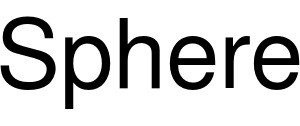

A sphere (from Greek σφαῖρα — sphaira, "globe, ball") is a perfectly round geometrical object in three-dimensional space that is the surface of a completely round ball (viz., analogous to the circular objects in two dimensions, where a "circle" circumscribes its "disk"). Like a circle in a two-dimensional space, a sphere is defined mathematically as the set of points that are all at the same distance r from a given point, but in a three-dimensional space. This distance r is the radius of the ball, which is made up from all points with a distance less than r from the given point, which is the center of the mathematical ball. These are also referred to as the radius and center of the sphere, respectively. The longest straight line through the ball, connecting two points of the sphere, passes through the center and its length is thus twice the radius; it is a diameter of both the sphere and its ball. While outside mathematics the terms "sphere" and "ball" are sometimes used interchangeably, in mathematics the above distinction is made between a sphere, which is a two-dimensional closed surface, embedded in a three-dimensional Euclidean space, and a ball, which is a three-dimensional shape that includes the sphere and everything inside the sphere (a closed ball), or, more often, just the points inside, but not on the sphere (an open ball). This distinction has not always been maintained and especially older mathematical references talk about a sphere as a solid. This is analogous to the situation in the plane, where the terms "circle" and "disk" can also be confounded.